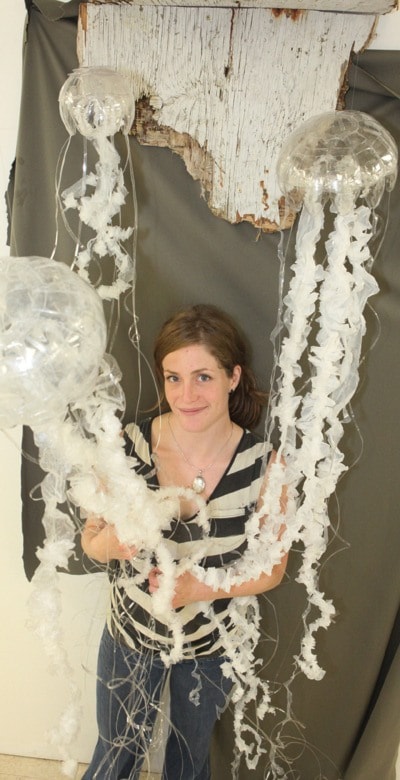The shimmering replicas of jellyfish may look fanciful but Vancouver Island University biology and art student Emily Rigney makes a serious statement with her sculpture created from shoreline trash.
“I live near the Pacific Biological Station and spend a lot of time on the beach. There is so much garbage, it’s astounding,” says Rigney.
Rigney, a fourth-year student at VIU, is majoring in biology with a minor in visual arts. Her latest arts assignment gave her a chance to combine her interests.
“I want to use art as a medium to relay environmental and biological messages. In my upper level biology courses I’m learning more and more that one of the big challenges in science is communicating with the public.”
She called her sculpture “Beach garbage jellyfish” and the name pretty much says it all.
“The day that we got this ‘Found Objects’ assignment I picked up 28 water bottles on the shoreline,” said Rigney.
Rigney cut up the discarded bottles and combined the pieces to create the bell shape of a lion’s mane jellyfish (Cyanea capillata). She found more than enough plastic bags to use for the tentacles of her sea creatures. She rounded out her salvaged material with six-pack rings used for beer and soft drinks.
“A specific message behind this piece is how easily garbage can look like jellyfish to humans. One can imagine how deceptive it can be to sea animals.”
“Emily’s sculpture is an excellent demonstration of how current issues in science affect artists,” said VIU Art and Design professor Fran Benton. “Emily has carefully constructed the jellyfish out of materials that are the opposite of what we usually use in sculpture. Rather than glass, bronze, or wood, she has meticulously crafted the work from pop bottles. Her use of the bottles is humorous but reminds us of the fragility of the marine environment and the dangers human culture poses to it.”
Rigney’s sculpture will be displayed at VIU’s new Deep Bay Marine Field Station. Rigney worked at the field station last summer on a research project aimed at restoring the Olympic Oyster population in Baynes Sound.
“We’re very excited about Emily allowing us to put her sculpture on permanent display,” said Field Station Manager, Brian Kingzett, who supervised Emily during her summer science position.
Rigney, who is heading toward a career in teaching, appreciates the balance of studying art and science.
— Submitted by Bruce
Patterson, writer/
communications officer, VIU.
